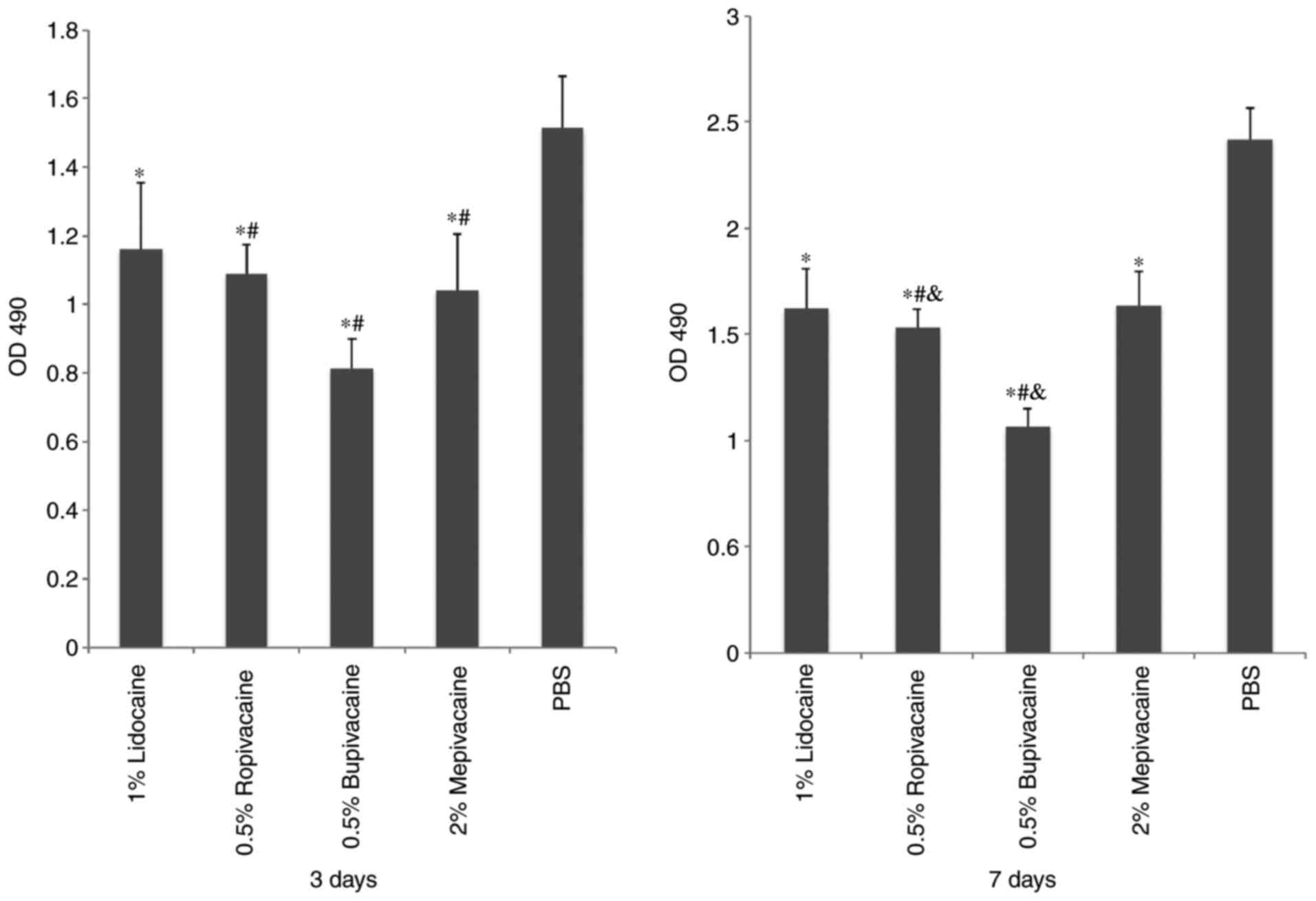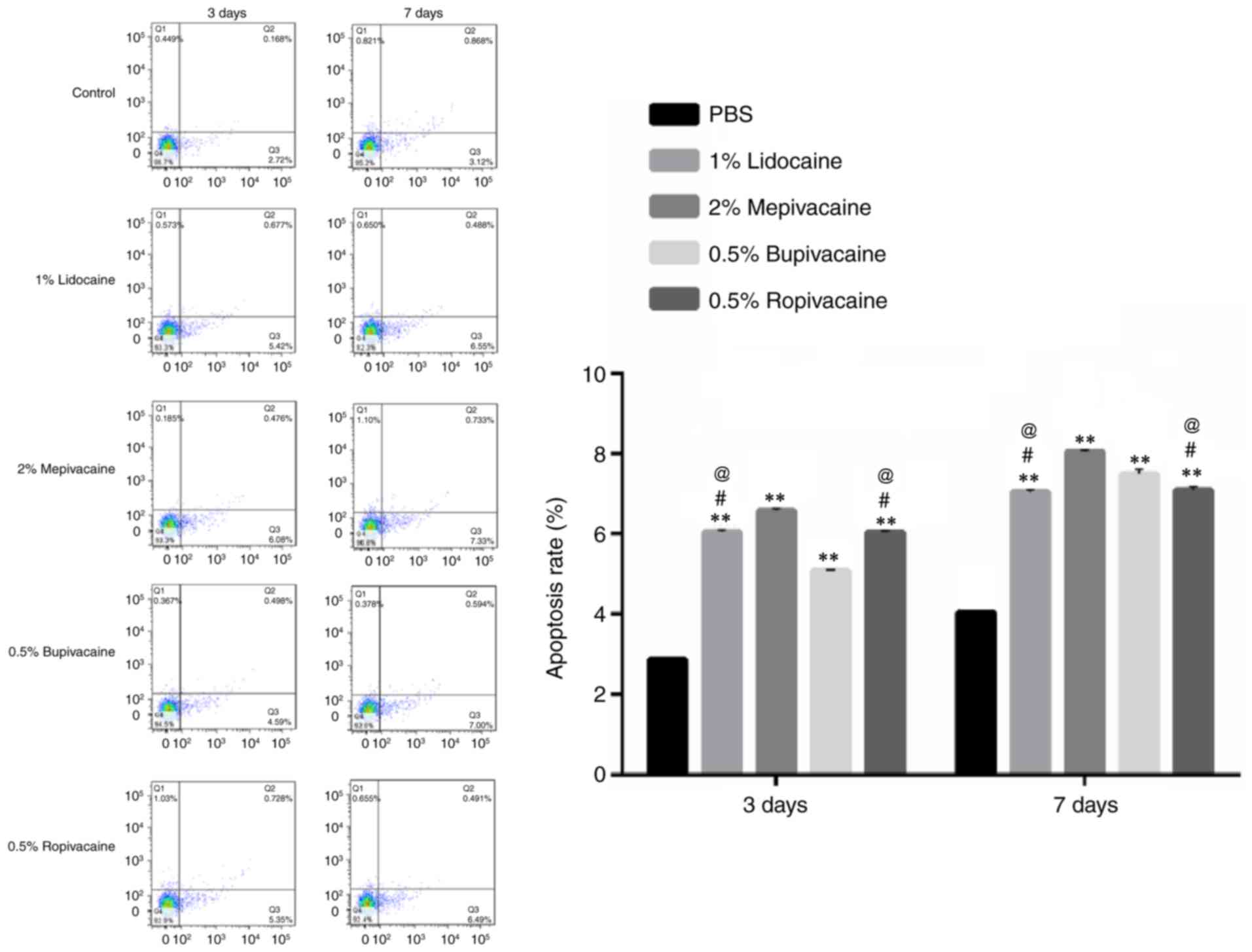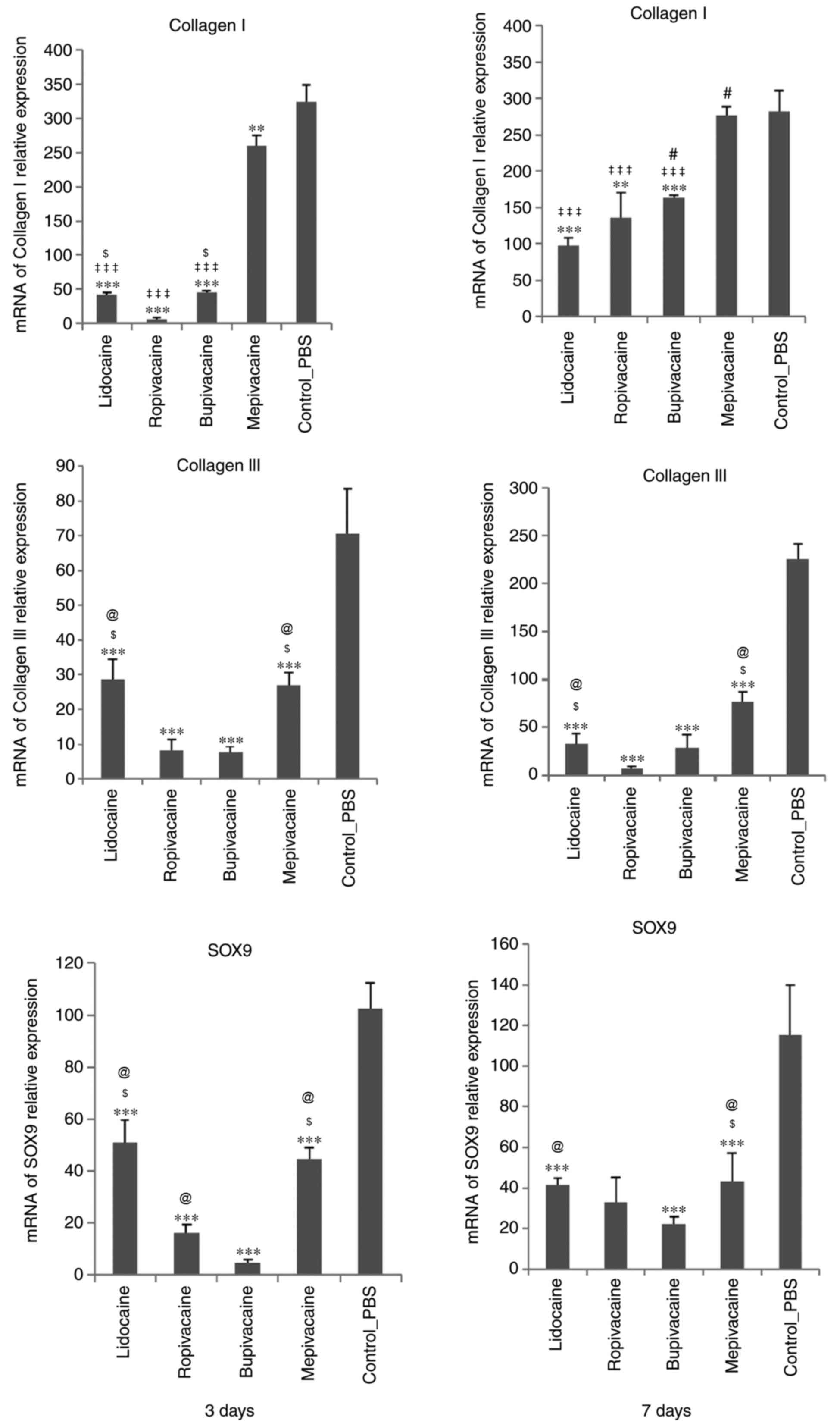|
1
|
Vos T, Flaxman AD, Naghavi M, Lozano R,
Michaud C, Ezzati M, Shibuya K, Salomon JA, Abdalla S, Aboyans V,
et al: Years lived with disability (YLDs) for 1160 sequelae of 289
diseases and injuries 1990–2010: A systematic analysis for the
Global Burden of Disease Study 2010. Lancet. 380:2163–2196. 2010.
View Article : Google Scholar
|
|
2
|
Wu T, Song HX, Dong Y and Li JH:
Cell-based therapies for lumbar discogenic low back Pain:
Systematic review and single-arm meta-analysis. Spine (Phila Pa
1976). 43:49–57. 2018. View Article : Google Scholar : PubMed/NCBI
|
|
3
|
Møiniche S, Mikkelsen S, Wetterslev J and
Dahl JB: A systematic review of intra-articular local anesthesia
for postoperative pain relief after arthroscopic knee surgery. Reg
Anesth Pain Med. 24:430–437. 1999. View Article : Google Scholar : PubMed/NCBI
|
|
4
|
Ballieul RJ, Jacobs TF, Herregods S, Van
Sint Jan P, Wyler B, Vereecke H, Almqvist F and Herregods L: The
peri-operative use of intra-articular local anesthetics: A review.
Acta Anaesthesiol Belg. 60:101–108. 2009.PubMed/NCBI
|
|
5
|
Chu CR, Izzo NJ, Coyle CH, Papas NE and
Logar A: The in vitro effects of bupivacaine on articular
chondrocytes. J Bone Joint Surg Br. 90:814–820. 2008. View Article : Google Scholar : PubMed/NCBI
|
|
6
|
Dregalla RC, Lyons NF, Reischling PD and
Centeno CJ: Amide-type local anesthetics and human mesenchymal stem
cells: Clinical implications for stem cell therapy. Stem Cells
Transl Med. 3:365–374. 2014. View Article : Google Scholar : PubMed/NCBI
|
|
7
|
Lucchinetti E, Awad AE, Rahman M, Feng J,
Lou PH, Zhang L, Ionescu L, Lemieux H, Thébaud B and Zaugg M:
Antiproliferative effects of local anesthetics on mesenchymal stem
cells: Potential implications for tumor spreading and wound
healing. Anesthesiology. 116:841–856. 2012. View Article : Google Scholar : PubMed/NCBI
|
|
8
|
Breu A, Eckl S, Zink W, Kujat R and Angele
P: Cytotoxicity of local anesthetics on human mesenchymal stem
cells in vitro. Arthroscopy. 29:1676–1684¸. 2013. View Article : Google Scholar : PubMed/NCBI
|
|
9
|
Breu A, Scheidhammer I, Kujat R, Graf B
and Angele P: Local anesthetic cytotoxicity on human mesenchymal
stem cells during chondrogenic differentiation. Knee Surg Sports
Traumatol Arthrosc. 23:937–945. 2015. View Article : Google Scholar : PubMed/NCBI
|
|
10
|
Zhu Y, Liu T, Song K, Fan X, Ma X and Cui
Z: Adipose-derived stem cell: A better stem cell than BMSC. Cell
Biochem Funct. 26:664–675. 2008. View
Article : Google Scholar : PubMed/NCBI
|
|
11
|
Romeo R, Carnovale C, Giofrè SV, Monciino
G, Chiacchio MA, Sanfilippo C and Macchi B: Enantiomerically pure
phosphonated carbocyclic 2′-oxa-3′-azanucleosides: Synthesis and
biological evaluation. Molecules. 19:14406–14016. 2014. View Article : Google Scholar : PubMed/NCBI
|
|
12
|
Garrido Pascual C, Hakimiyan AA, Rappoport
L, Oegema TR, Wimmer MA and Chubinskaya S: Anti-apoptotic
treatments prevent cartilage degradation after acute trauma to
human ankle cartilage. Osteoarthritis Cartilage. 17:1244–1251.
2009. View Article : Google Scholar : PubMed/NCBI
|
|
13
|
Livak KJ and Schmittgen TD: Analysis of
relative gene expression data using real-time quantitative PCR and
the 2(-Delta Delta C (T)) method. Methods. 25:402–408. 2001.
View Article : Google Scholar : PubMed/NCBI
|
|
14
|
Asik M, Ciftci F, Sen C, Erdil M and
Atalar A: The microfracture technique for the treatment of
full-thickness articular cartilage lesions of the knee: Midterm
results. Arthroscopy. 24:1214–1220. 2008. View Article : Google Scholar : PubMed/NCBI
|
|
15
|
Xia P, Wang X, Lin Q and Li X: Efficacy of
mesenchymal stem cells injection for the management of knee
osteoarthritis: A systematic review and meta-analysis. Int Orthop.
39:2363–2372. 2015. View Article : Google Scholar : PubMed/NCBI
|
|
16
|
Løken S1, Jakobsen RB, Arøen A, Heir S,
Shahdadfar A, Brinchmann JE, Engebretsen L and Reinholt FP: Bone
marrow mesenchymal stem cells in a hyaluronan scaffold for
treatment of an osteochondral defect in a rabbit model. Knee Surg
Sports Traumatol Arthrosc. 16:896–903. 2008. View Article : Google Scholar : PubMed/NCBI
|
|
17
|
Haleem AM, Singergy AA, Sabry D, Atta HM,
Rashed LA, Chu CR, El Shewy MT, Azzam A and Abdel Aziz MT: The
clinical use of human culture-expanded autologous bone marrow
mesenchymal stem cells transplanted on platelet-rich fibrin glue in
the treatment of articular cartilage defects: A pilot study and
preliminary results. Cartilage. 1:253–261. 2010. View Article : Google Scholar : PubMed/NCBI
|
|
18
|
Piper SL, Kramer JD, Kim HT and Feeley BT:
Effects of local anesthetics on articular cartilage. Am J Sports
Med. 39:2245–2253. 2011. View Article : Google Scholar : PubMed/NCBI
|
|
19
|
Keck M, Zeyda M, Gollinger K, Burjak S,
Kamolz LP, Frey M and Stulnig TM: Local anesthetics have a major
impact on viability of pre-adipocytes and their differentiation
into adipocytes. Plast Reconstr Surg. 126:1500–1505. 2010.
View Article : Google Scholar : PubMed/NCBI
|
|
20
|
Chang YS, Tseng SY, Tseng SH and Wu CL:
Cytotoxicity of lidocaine or bupivacaine on corneal endothelial
cells in a rabbit model. Cornea. 25:590–596. 2006. View Article : Google Scholar : PubMed/NCBI
|
|
21
|
Pollock JE: Neurotoxicity of intrathecal
local anaesthetics and transient neurological symptoms. Best Pract
Res Clin Anaesthesiol. 17:471–484. 2003. View Article : Google Scholar : PubMed/NCBI
|
|
22
|
Punke MA and Friederich P: Lipophilic and
stereospecific interactions of amino-amide local anesthetics with
human Kv1.1 channels. Anesthesiology. 109:895–904. 2008. View Article : Google Scholar : PubMed/NCBI
|
|
23
|
Werdehausen R, Fazeli S, Braun S, Hermanns
H, Essmann F, Hollmann MW, Bauer I and Stevens MF: Apoptosis
induction by different local anaesthetics in a neuroblastoma cell
line. Br J Anaesth. 103:711–718. 2009. View Article : Google Scholar : PubMed/NCBI
|
|
24
|
Grouselle M, Tueux O, Dabadie P,
Georgescaud D and Mazat JP: Effect of local anaesthetics on
mitochondrial membrane potential in living cells. Biochem J.
271:269–272. 1990. View Article : Google Scholar : PubMed/NCBI
|
|
25
|
Fu X, Han B, Cai S, Lei Y, Sun T and Sheng
Z: Migration of bone marrow-derived cells induced by tumor necrosis
factor-alpha and its possible role in wound healing. Wound Repair
Regen. 17:185–191. 2009. View Article : Google Scholar : PubMed/NCBI
|
|
26
|
Tanaka Y, Maruo A, Fujii K, Nomi M,
Nakamura T, Eto S and Minami Y: Intercellular adhesion molecule 1
discriminates functionally different populations of human
osteoblasts: Characteristic involvement of cell cycle regulators. J
Bone Miner Res. 15:1912–1923. 2000. View Article : Google Scholar : PubMed/NCBI
|
|
27
|
Feinstein DL, Murphy P, Sharp A, Galea E,
Gavrilyuk V and Weinberg G: Local anesthetics potentiate nitric
oxide synthase type 2 expression in rat glial cells. J Neurosurg
Anesthesiol. 13:99–105. 2001. View Article : Google Scholar : PubMed/NCBI
|
|
28
|
Shoshani O, Berger J, Fodor L, Ramon Y,
Shupak A, Kehat I, Gilhar A and Ullmann Y: The effect of lidocaine
and adrenaline on the viability of injected adipose tissue: An
experimental study in nude mice. J Drugs Dermatol. 44:311–316.
2005.
|


















